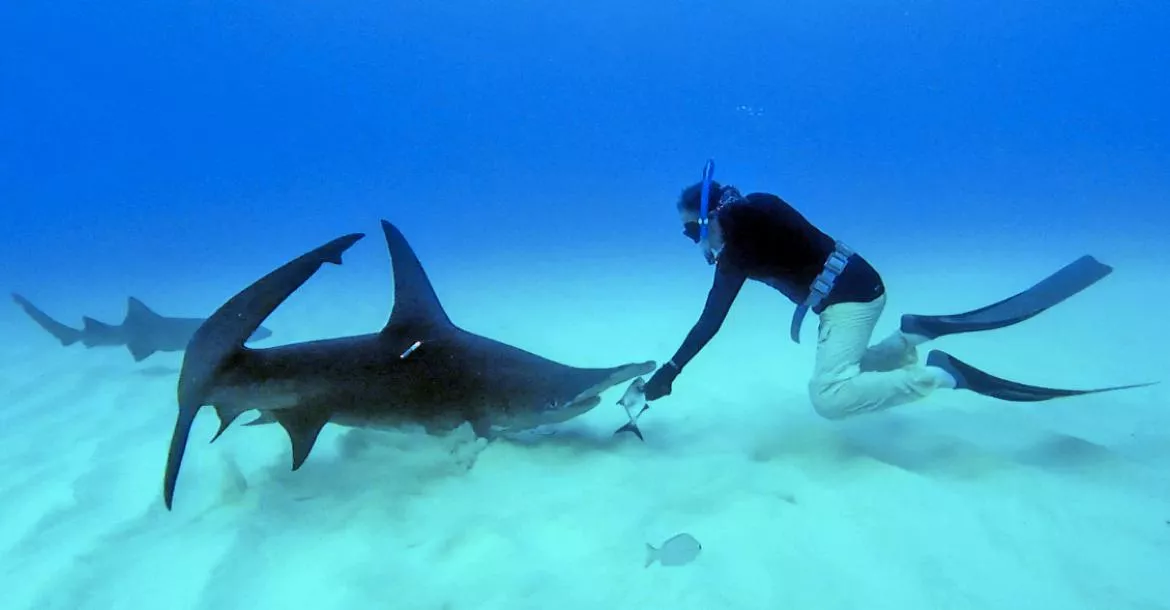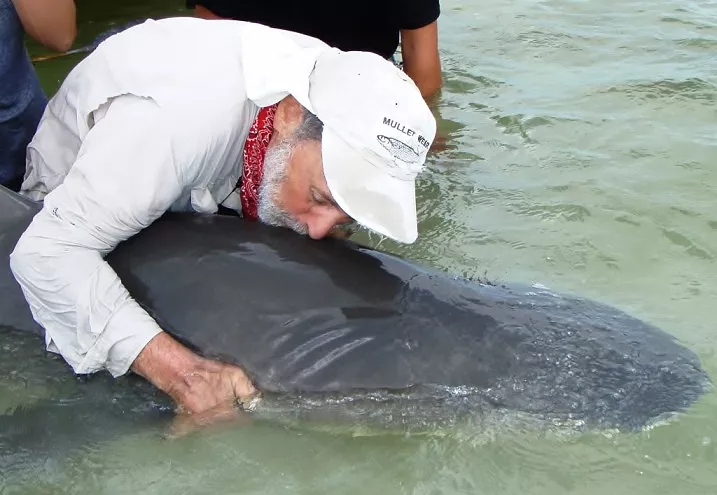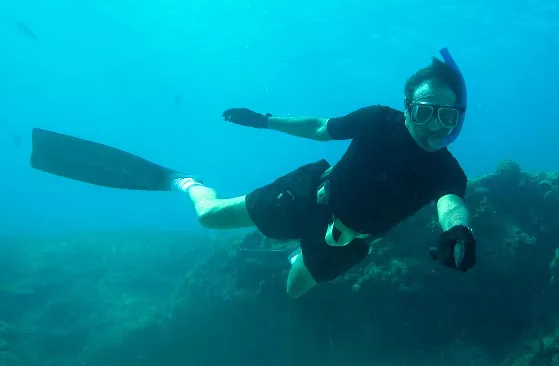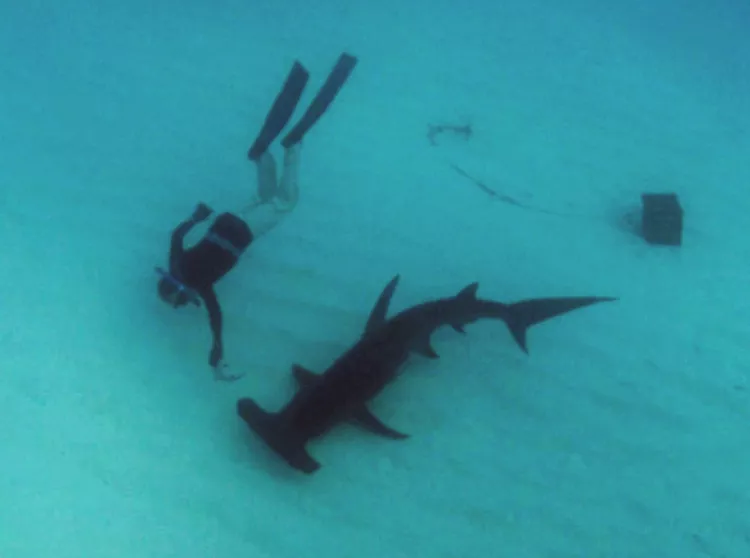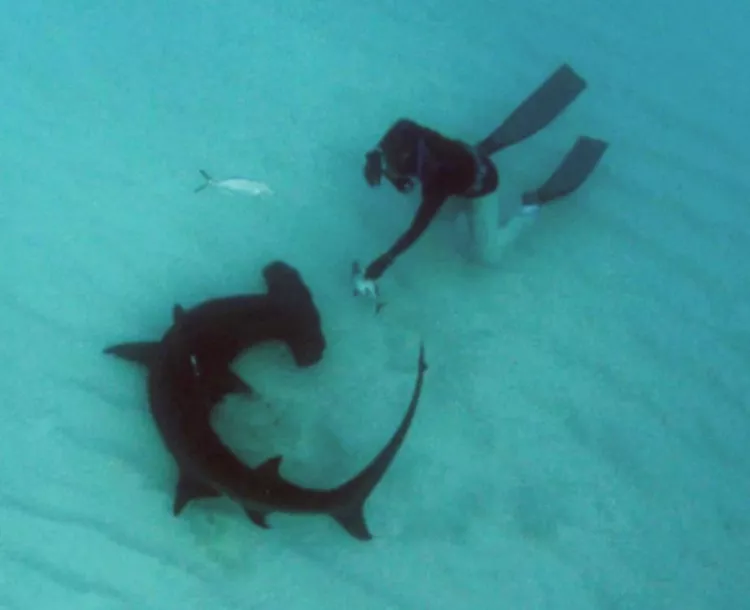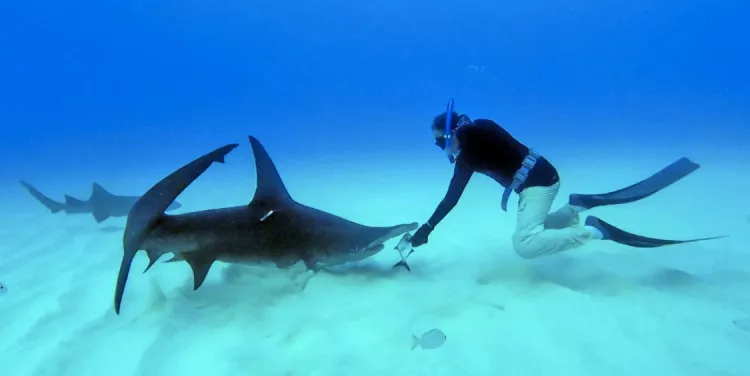Samuel H. "Doc" Gruber began studying sharks in 1961, perhaps before any other scientist had done full-time research on a living shark. During his long career, he founded the Bimini Biological Field Station (Shark Lab), the Shark Specialist Group of the International Union for the Conservation of Nature (IUCN), a United Nations organization based in Switzerland, and the American Elasmobranch Society. He has published over 200 scientific papers, and his work is still ongoing today. This is part three, the final installment of the story of his work and life.
Contributed by
Factfile
Ila France Porcher, author of The Shark Sessions, is an ethologist who focused on the study of reef sharks after she moved to Tahiti in 1995.
Her observations, which are the first of their kind, have yielded valuable details about their lives, including their reproductive cycle, social biology, population structure, daily behaviour patterns, roaming tendencies and cognitive abilities.
Her next book, On the Ethology of Reef Sharks, will soon be released.
Since his riveting meeting with the hammerhead shark at the age of 20, Gruber had focused on trying to learn all he could about sharks. Yet his interest had not extended to conservation. But already when he wrote his doctoral dissertation in 1968 he knew that sharks were in trouble. By the time the ‘60s passed into the ‘70s, some scientists were unsure whether or not they could ever be sustainably exploited.
By 1979 he had established a research site where he pursued his studies on the needs of young, growing lemon sharks. Using nets, each year he would catch between 100 and 120 baby lemon sharks in a shark nursery called Coupon Bight, in the Florida Keys. He would examine, tag, and release these baby sharks again. But after several years, in the early '80s, this number began to fall. In three years it fell from 100 sharks to zero. He could not find a single lemon shark pup in Coupon Bight.
That was when it became personal. He knew that lemon sharks were in deep trouble now, because he had personally observed and recorded their disappearance.
Gruber felt personally angered. Not only was his careful work during all of those years wasted, but the loss of the entire local population of sharks by gill-net fishing seemed an inexcusable excess.
He found out that the pups had been lost to overfishing. Fishermen had been going there to get the little baby sharks during a period of about twenty years, and had fished them all out. The mothers who should have returned to have more babies never got the chance to grow to maturity because they were killed in the place they were born.
Research at Bimini later revealed that the mature females return to their birthplace to bear pups, so after about 12 years if no lemon sharks are permitted to grow to maturity, there will be no new cohorts of lemon shark babies born. This is what happened in the Florida Keys, and why his study population fell to zero. The rapidity with which a local population could be destroyed was stunning to him.
Thus, he began to write about what he had seen, and the word got around, because he wrote some scathing articles about the overfishing of sharks.
Founding the American Elasmobranch Society
Gruber founded the American Elasmobranch Society in 1983. At the time, he remembers, there was great interest on the part of scientists to get funding to study sharks. But it was very difficult to get a grant to study, and his colleagues wondered how to go about it, particularly when Gruber received such grants regularly. Gruber didn't know how he did it—perhaps it was just his luck. At the time, in the early eighties, he was no longer funded by the Navy, but had remained good friends with his scientific officer, Dr Bernie Zahuranec at the Office of Naval Research.
In 1981, there was a meeting on great white sharks, hosted by the California Academy of Sciences. This was the first meeting of its kind, and everyone who was interested in white sharks attended.
During the sessions, Gruber was approached by a group of colleagues, who told him that they wanted to get together form a society to generate interest in getting shark research funded. There was a meeting at the poolside with Dr Zahuranec, Dr Don Nelson, and Dr Leonard Compagno, and they all put forth their ideas, and hashed out what it would take to establish an academic society.
Afterwards, though he was still fighting his cancer with toxic chemotherapy, Gruber worked on the plan. He produced by-laws, contacted everyone by letter, telephone, or fax, (there was no e-mail or Internet back then) and eventually he gathered together the group and they commissioned him to go forward.
They all said, “Yes we want this, we will support your plan,” but it mostly verbal as Gruber recalled. It was basically a one-man operation, but Dr Zahuranec was very encouraging and helpful.
Finally, in 1983, with the help of his father, Sidney, who was a banker, and his brother, Herbert, Gruber founded and incorporated the American Elasmobranch Society in the State of Florida and later was granted non-profit status. He funded it with his own money.
With the assistance of Dr Zahuranec, Gruber even donated 11,000 dollars to the foundation—in the eighties that was a lot of money—to set up a fund for students who submitted the best research papers at the annual Society meeting. It is still in place today, and is called the Gruber award.
Gruber ran The American Elasmobranch Society for five years, by which time it was well established, and he could hand it over to others who would keep it going. Now, 32 years later, with over 500 members from around the globe, it is the largest society dedicated to shark research in the world.
The Shark Specialist Group, of IUCN
At the 1991 annual meeting of the AES in New York city, a gentleman from Species Survival Commission, of the International Union for the Conservation of Nature, (IUCN) got up in front of the large audience and announced, “Will Dr Gruber please come up!”
His name was George Rabb and he was the chairman of the Species Survival Commission (SSC), a science-based network of volunteer experts from around the world. The SSC is the group which sets up the IUCN specialist groups. Its goal is the achievement of “a just world that values and conserves nature through positive action to reduce the loss of diversity of life on earth”.
Rabb began a presentation on the need to protect sharks from further decimation through the establishment of a Shark Specialist Group, and declared that Gruber ought to be the one to take charge. An astonished Gruber asked if he had the right person in mind, since he knew nothing about conservation, but Rabb had looked at Gruber's work, and was convinced that he did. So Gruber agreed to give it a try.
With his usual intensity, he threw himself into the work. Systematically, he built it up, got the right people involved, and established networking groups around the world. He worked as director of the new Shark Specialist Group (SSG) for five years, and got it up and running, until it was able to go on by itself.
Gruber saw his role as an instigator—he was the person who had an idea, and who went for it—who got things started, and then handed them over to those who were better at running them. It was characteristic of him to make a decision, and then drive ahead as if there was no turning back—he knew only one way to go, and that was forward. Always he had a strong spirit and an iron will, to go ahead and accomplish what he had in mind, no matter what it took.
It was the same when he went to military prep school. Though he found it hard, very hard, he was determined to make it no matter what it took—there was no turning back. He went ahead and did exceptionally well. That was characteristic of him.
The great hammerhead shark revisited
Though long past retirement, Gruber continues to savour every moment of his life. He is still involved with research at Bimini, and on free afternoons, enjoys himself flying in vintage WWII aircraft over the blue seas of Florida and California.
He is often interviewed by the media on the subject of sharks, and appears regularly on National Geographic, where he holds the position of NGS Explorer. He also appears on Discovery and BBC Natural History shows, in his personal mission to help change public attitudes to these maligned and misunderstood animals.
During a recent filming for Discovery, he dove down to hand a fish to a large, circling hammerhead, and remembered again his dramatic meeting as a young man, with the majestic shark that had inspired his career.
At that time, like everyone else, he had never doubted that sharks were insatiable killers. There had been so many stories about them coming out of WWII, when sharks had devoured the crews of sinking ships, and planes that had ended up in the ocean, that everyone believed that they were the horror of the ocean. In 1958, there was one over-arching theme in the public attitude to them—the only good shark is a dead shark.
But during his dramatic meeting with the hammerhead, in spite of his fear, he had felt a deep need to find out something more about them. After all, many animals are predators, and even a cow will kill in the right situation. During the intervening decades, he has found out about them, and what he has learned, is that it was all wrong. To think that sharks are the devil-fish from hell, was wrong from every point of view.
“Sharks are not man-eaters or woman-eaters, he declares. “If you want to find a man-eater, you have to look at the Nile crocodile, which kills and eats upwards of a dozen victims year, or Bengal tigers, which stalk humans in the Sundarband (India) tiger reserve and kill an average of 23 people a year, year in and year out.
“Sharks kill a few people, but compared to most everything else, they are not even on the radar.
“Originally, our understanding of the role of sharks was that they would eat you and so they should be killed. Not only the lay public, but many of the most important marine scientists believed that. Fifty years later, when we have come close to succeeding, we have found out that the role that sharks play in the ocean is so crucial, that we are turning the ocean into a sick ocean by killing them.
“In fact, the only good shark is the one that is swimming around outside the reef taking care of the environment for us, and keeping it cleaned up. There has been an 180-degree turnaround in thinking about the role of sharks. Gruber is grateful to the various conservation societies, such as PEW, for protecting sharks. They are doing a wonderful job, and he hopes that this change in the public attitude towards saving sharks has come in time.
This time, when he dove down towards the great circling hammerhead, he felt no fear, because he knew that there is no real concern about such a shark attacking a person in the sea. There may still have been doubt about that even 12 to 14 years ago, but now, he is sure of it. As he handed the fish to the shark he was aware only of its streamlined beauty, and felt the deep familiar thrill, just to be there, with the shark.
“Sharks are very smart,” he said. “They learn quickly, and they are only interested in the food you bring.”
Sharks and the ocean
Sharks have been evolving for half a billion years, separately from all other vertebrates, so they represent an ancient, and very different, evolutionary line of animals.
“Though they are commonly referred to as fish, in fact, they are as different from fish as a frog is different from an elephant,” Gruber explains. “Their internal fertilization has produced a completely different life history strategy—sharks operate more like sea turtles and whales than they do like fishes in their strategy of birth and fecundity and their maternal investment in the babies.”
“Because of their long and independent evolutionary history, sharks have developed very highly evolved organ systems. Their heart is more like a mammal’s than a fish’s, their kidneys are more like a mammal’s than a fish’s, and their brains are large, correlating with their learning capabilities. Their behavioural repertoire is very complicated with regards to such things as mating and courtship—things we know nothing about—much more complicated that what we see in other fish-like vertebrates.”
During this long evolution, sharks survived many extinctions, and each time, they adapted to the niches left by the species that died out. Repeatedly they took advantage of the extinctions because niches opened for them to fill—this is called adaptive radiation.
This was how sharks evolved many forms, including the hammerhead, and display great diversity. The hammerhead shark has turned out to be a very modern species, having evolved in just the last thirty million years. It is an apex animal in every way—in terms of size, social behaviour, feeding, bio-chemistry, and biology.
Contrary to common belief, not all sharks are top predators—some are bottom feeders, some eat fish. The largest sharks, such as the whale shark and the basking shark, are filter feeders, while others eat whales. They have adapted to a wide variety of niches, from the sunlit shallows, to the depths of the abyss, and their influence is felt from the top to the bottom of the ocean's food chain.
The ocean has developed sharks, and they have been shaping its ecology since life emerged from the oceans, back near the beginning of vertebrate history. They were the animals successful enough to survive extinctions, while other species died out. And yet, we have specifically targeted them, and are driving them right into extinction. Out of hate, or for their fins and other frivolous products, we are killing the very fabric of the ocean ecosystems.
So Gruber's final word is a warning. The killing must stop, or one day we may find that by killing off the sharks, we have destroyed the ocean's vitality. Its ability to continue to play its role as part of the life-support system of our earth will certainly be impacted. ■

